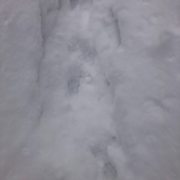Dispatch from the Sugarwoods, 2021, Part 2
The first sap runs of the year came right on schedule last week, though because I’m still trying to get tapped and achieve good vacuum levels, I didn’t capture the sap. On a normal year Dad and I would have divided the labor; he’d have collected and boiled, I’d have stayed working in the woods. But he’s nursing a leg injury this year and largely unavailable. In light of this, it made more sense to me to try to get the woods right first and then worry about the sap later.
So what does good vacuum level mean? Technically-speaking, it means a system that holds over 25 hg (inches of mercury). “Inches of mercury” is a standard measurement that expresses the difference between ambient atmospheric pressure and the pressure that’s being created by your vacuum. At 25 inches, you can pull a tap from a tree and the vacuum roars. If the sap’s running, it’ll arc from the hole and into the spout. Stick the spout to the end of your finger and it bites a bit. But it’s work to get to those levels. Sugarmakers who work on a commercial scale leave their lines up all year, and squirrel chews and fallen-tree-limb damage and cracks from aging infrastructure all degrade the system. Once we’re tapped, the vacuum level is usually around 10 to 15 inches; we then have to go back, line by line, over the whole system to get it tight. What’s the payoff? Sugarmakers throw around the statistic that every inch of mercury equals 5 percent more sap. I think the reality is more nuanced than that simple statistic, but it gives you an idea of why someone would let the first sap of the year run on the ground and work on lines instead. It’s a short-term loss that is, in theory, overcome by long-term gain.
Turning from the practical to the poetic, there’s something endearing about this year’s deep snow if you can overlook the loss of efficiency. On low-snow years, you navigate the woods haphazardly, following the straightest line from point a to point b. But on years like this, you create snowshoe-packed highways that are essentially a road system through the woods. Little snow-rooms develop where you’ve beaten down a whole area – these places are where you cache equipment or break for lunch. The animals who are out use the paths, too. Each morning you’ll see fresh deer tracks, or coyote or fox tracks, along your highways. Last Tuesday, a raccoon made its way out of a big maple cavity tree and meandered the trail system.

